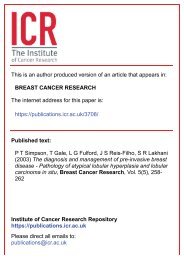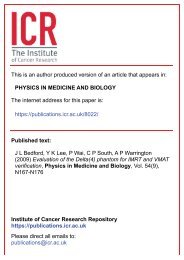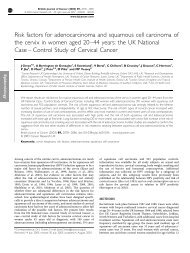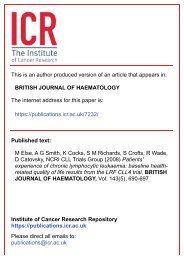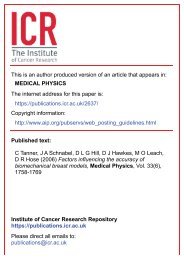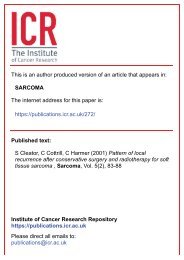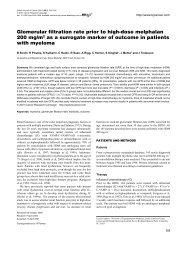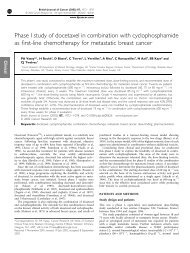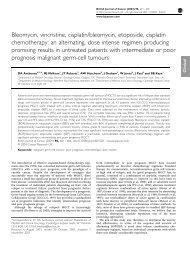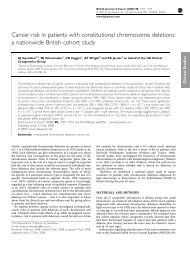BMC Genomics 2008, 9:591http://www.biomedcentral.com/1471-2164/9/591and luminal <strong>subpopulations</strong> for gene expression pr<strong>of</strong>iling,to identify genes found in common between thesedatasets and our own data [see Additional files 8, 9, 10].There was good concordance between the genes identifiedin our data and that <strong>of</strong> Stingl and colleagues [6] in theirstudy <strong>of</strong> separated mouse epithelium. They identified 128probes, corresponding to 80 well-annotated genes, significantlyupregulated in their myo<strong>epithelial</strong>/<strong>mammary</strong>stem cell enriched cell fraction compared to their <strong>mammary</strong>colony forming cells (corresponding to the luminalcell fraction). Of these 80 genes, 49 (61%) were significantlyenriched in our basal/myo<strong>epithelial</strong> cell dataset,three were enriched in both the basal/myo<strong>epithelial</strong> cellsand the luminal ER + cells and two were enriched in boththe basal/myo<strong>epithelial</strong> cells and the luminal ER - cells [seeAdditional files 8 and 9]. Conversely, Stingl and colleaguesidentified 102 probes, corresponding to 66 wellannotatedgenes, significantly downregulated in theirmyo<strong>epithelial</strong>/<strong>mammary</strong> stem cell enriched cell fractioncompared to their <strong>mammary</strong> colony forming cells. Ofthese, which would correspond to genes enriched in theluminal <strong>epithelial</strong> fraction, none were enriched in ourbasal/myo<strong>epithelial</strong> population but 28 (42%) wereenriched in both our luminal populations, five wereenriched only in the luminal ER - cells and four only in theluminal ER + cells [see Additional files 8 and 10]. However,correspondence <strong>of</strong> our data with previously publisheddatasets from separated human cells [27-29] was lower,although it tended to be better between the mousemyo<strong>epithelial</strong> and human myo<strong>epithelial</strong> data sets thanbetween the luminal data sets from the different species[see Additional files 8, 9, 10].Interaction mapping <strong>of</strong> genes differentially expressed in<strong>mammary</strong> <strong>epithelial</strong> <strong>subpopulations</strong> identifies keyprocesses and novel functionsTo get a better understanding <strong>of</strong> the key biological processesoccurring in each <strong>of</strong> the three cell types, we generatednetwork interaction maps for the differentiallyexpressed genes [see Additional files 11, 12, 13]. Interactiondata derived from studies on human orthologues <strong>of</strong>the genes identified were used to create the network maps,as there is not enough data currently available purely fromstudies <strong>of</strong> mouse genes to make such an <strong>analysis</strong> meaningful.When a basal/myo<strong>epithelial</strong> interaction map was constructedusing both the differentially expressed genes andgenes interpolated by the network mapping program(which allow connections to be extended and elaborated),the resulting network was extraordinarily complex(data not shown). For ease <strong>of</strong> interpretation, therefore, abasal/myo<strong>epithelial</strong> network was constructed using onlydirect interactions between genes characteristic <strong>of</strong> this cellpopulation, with no interpolations [see Additional file11]. This network identified two major interaction 'modules'and three minor ones. Such interaction modules areindicative <strong>of</strong> important processes occurring within a cell,as they are composed <strong>of</strong> cell-type specific genes anddefined by multiple interactions between those genes. Thetwo major interaction modules can be broadly characterisedas an extracellular matrix module including multiplecollagen genes and a cytoskeletal module including genesfor the keratins, vimentin, and genes whose protein productsare involved in regulation <strong>of</strong> cell shape, movementand contractility, such as the actin binding proteinsMYH10 [32] and TPM2 [33] and smooth muscle gammaactin ACTG2 [34]. The minor modules indicated that thebasal/myo<strong>epithelial</strong> cell population also has importantprocesses based around Platelet-Derived Growth Factor(PDGF), Ephrin and Insulin-Like Growth Factor (IGF1)signalling. Ephrins are mediators <strong>of</strong> contact-dependentcommunication between cells [35] whereas both PDGFand IGF1 signalling are involved in paracrine cell-cellcommunication [36,37].The luminal interaction maps were built using both cellspecificgenes and interpolated genes [see Additional files12 and 13]. As a result, it was less straightforward to definecell-specific interaction modules which would indicatethe key cellular processes occurring in these cell types. Wetherefore developed a mathematical approach to definingthe modules which required the assignment <strong>of</strong> networkhubs, node clusters and contiguous differentiallyexpressed network paths. To define network hubs (nodeshaving multiple interactions), nodes were ranked bydescending connectivity. The minimum node connectivityin the top 10% <strong>of</strong> nodes was five for either network andthis was therefore set as a threshold for identifying hubs.Differentially expressed hubs for the luminal ER - and ER +networks are listed in Tables 1 and 2 respectively. Therewas limited overlap between the luminal ER - and ER + networkhubs with only three differentially expressed hubsbeing shared (ERBB3, KRT18 and CD82). The majority <strong>of</strong>hubs in both networks had a high content <strong>of</strong> physicalinteractions with the exception <strong>of</strong> TNF, SP1, FAS, NFKB1CREB1, EGR1 and SPI1, which are almost exclusively transcriptionalhubs. In the luminal ER - network TLR4, LY96,ERBB3, MUC1 and CD82 were differentially expressedhubs with significant clustering character, although thestrongest clustering was seen for the non-differentiallyexpressed hubs EGFR and ERBB2. Clustering was less pronouncedin the luminal ER + network with PGR, ERBB3,FGG, FGB, CD82 and COL8A1 forming significantly clustereddifferentially expressed hubs. With the exception <strong>of</strong>TLR4 and LY96 in the luminal ER - network, clustering andconnectivity were inversely correlated, with high connectivitynodes such as ESR, PTN, CCL5, TNF and BCL2,exhibiting very little or no clustering.Page 7 <strong>of</strong> 28(page number not for citation purposes)
BMC Genomics 2008, 9:591http://www.biomedcentral.com/1471-2164/9/591Table 1: Hubs and clustered nodes in the luminal ER - network.Hub k node C node Differentially expressedneighboursPhysical interaction contentTranscriptional interactioncontentCCL5* 17 0.000 0 35% 65%TLR4* 17 0.103 2 82% 18%TNF* 15 0.000 0 13% 87%BCL2* 14 0.000 2 60% 40%LY96* 14 0.154 2 100% 0%KIT* 13 0.013 3 92% 8%CCL2* 10 0.000 0 40% 60%LYN* 10 0.022 1 100% 0%ERBB3* 9 0.194 3 100% 0%SP1 9 0.000 8 0% 100%FAS* 8 0.000 0 25% 75%MUC1* 8 0.143 1 100% 0%GRB2 7 0.000 6 100% 0%UBQLN4 7 0.000 6 100% 0%CD82* 6 0.133 1 100% 0%KRT18* 6 0.067 1 83% 17%NFKB1 6 0.000 5 0% 100%ATXN1 5 0.000 4 100% 0%CD14* 5 0.100 2 40% 60%CREB1 5 0.000 4 20% 80%EGFR 5 0.300 4 100% 0%ERBB2 5 0.300 4 100% 0%MAPK1 5 0.000 4 100% 0%PIK3R1 5 0.000 4 100% 0%RPS6KA5* 5 0.000 0 100% 0%SPI1 5 0.000 4 0% 100%*Differentially-expressed genes. K node , node connectivity, C node , node clustering coefficient, calculated as C node = 2 n node /(k node (k node - 1)) wheren node is the number <strong>of</strong> interactions between the hub first neighbours. Hubs exhibiting clustering are shown in bold. High content <strong>of</strong> physical ortranscriptional interactions in the hub is shown in bold.To identify modules within the networks, a three-passapproach was adopted [see Additional file 14]. Initially alldifferentially expressed hubs were identified and, wheredirect links existed between them in the network, thesewere used to provide the backbone for each module. Inthe second pass, modules were allowed to expand by theaddition <strong>of</strong> differentially expressed nodes with lower connectivity(such that they did not qualify as hubs), if theywere directly linked to differentially expressed hubs. Inthe third pass, non-differentially expressed hubs wereincorporated, if they were connecting at least two differentiallyexpressed hubs. This step allowed for bridgingbetween modules, providing further information abouttheir proximity and global topology within the luminalER - and luminal ER + networks [see Additional files 15 and16].Following the initial two passes, four distinct moduleswere established for the luminal ER- network [see Additionalfiles 14 and 15]: the TLR (nodes TLR4, LY96 andCD14), KIT (nodes KIT, ERBB3, LYN, TEC, GRB7, MUC1and CD82), KRT (nodes KRT18 and KRT8) and BCL2(nodes BCL2, BIK and BNIPL) modules (Table 3). NodesTNF, FAS, CCL5, CCL2 and RPS6KA5 were integrated inthe BCL2 subnet only at the third pass through a network<strong>of</strong> transcriptional interactions, forming the TNF/FASmodule [see Additional file 14]. In addition, the KRTmodule merged into the KIT module at this stage. The TLRand KIT modules contained predominantly physical interactionswhereas the TNF/FAS module displayed a verystrong transcriptional character (82%). The three modulesexhibit topological proximity, defining a single subnetworkwith 39 connections and 27 nodes [see Additionalfiles 14 and 15]. Compared to the luminal ER- networkoverall, this subnetwork showed higher clustering and,whilst maintaining the average network connectivity, itexhibited a significantly shorter mean shortest path and avery low power exponent. Removing this subnetworkfrom the overall luminal ER- network yielded a highlyfragmented graph ('non-module subnetwork') with noclustering and very low connectivity [see Additional file17].For the luminal ER + network, six distinct modules wereobserved following the initial two passes [see Additionalfiles 14 and 16]: the ESR (nodes ESR1, PGR, GADD45G,Page 8 <strong>of</strong> 28(page number not for citation purposes)
- Page 1: This is an author produced version
- Page 4 and 5: BMC Genomics 2008, 9:591http://www.
- Page 6 and 7: BMC Genomics 2008, 9:591http://www.
- Page 10 and 11: BMC Genomics 2008, 9:591http://www.
- Page 12 and 13: BMC Genomics 2008, 9:591http://www.
- Page 14 and 15: BMC Genomics 2008, 9:591http://www.
- Page 16 and 17: BMC Genomics 2008, 9:591http://www.
- Page 18 and 19: BMC Genomics 2008, 9:591http://www.
- Page 20 and 21: BMC Genomics 2008, 9:591http://www.
- Page 22 and 23: BMC Genomics 2008, 9:591http://www.
- Page 24 and 25: BMC Genomics 2008, 9:591http://www.
- Page 26 and 27: BMC Genomics 2008, 9:591http://www.
- Page 28 and 29: BMC Genomics 2008, 9:591http://www.



